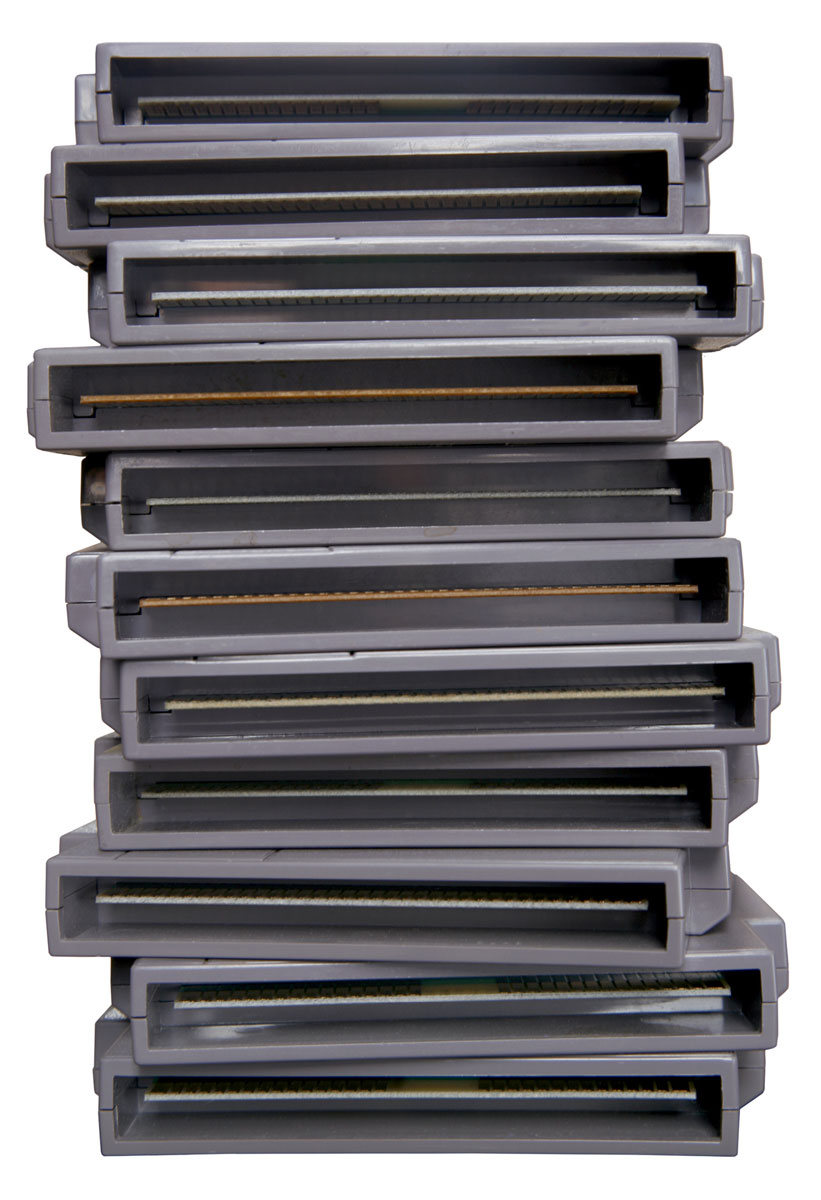Kiss of Life
How to resuscitate old Nintendo games
Raiford Guins

The games all work great but haven’t been played in years so may be a little dusty to a lot dusty.
—eBay description for lot of thirty-two Nintendo NES Games
Lips pursed: blow. Warm air rushes across metal connector pins, along the exposed edge of the thin printed circuit board (PCB) peering out of its protective plastic case. The game cartridge’s metal contacts are dirty, littered with the debris of both late twentieth-century and early twenty-first century life. In symphony, the television screen flashes blue and the Nintendo Entertainment System’s (NES) power button blinks red as my game cartridge struggles in vain to offer its 8-bit ROM program to the console’s 72-pin connector. Despite being fortressed within a recess of durable ABS plastic, the cartridge’s little metal contacts are not immune to it: dust.
This is not the first time that I’ve kissed a game cartridge. After a lifetime of playing video games, and now, more recently, having been happily tasked with constructing a university archive of such games, I am called upon with increasing frequency to perform this wanton act. I am not alone; many gamers blow. We must regularly exorcise dust from game cartridge pins as a result of the NES’s front-loading cartridge socket design flaw. The insertion of cartridges into the NES puts pressure on the connector pins, wearing them out and rendering them incredibly sensitive to the cling of dust and grime. NES mouth-to-mouth resuscitation is hardly an ideal solution. It is, nonetheless, a requisite practice for gamers and archivists who lovingly revive antiquated cartridge-based games. The preferred method for restoring life (or, more precisely, “memory,” as PCBs contain a game’s ROM) is coaxing a cotton swab dipped in isopropyl rubbing alcohol along the cartridge’s contacts until it is primed for play.
This isn’t the image of video games that springs to mind when we clutch next-generation controllers to work inches off our waistline with Wii Fit. Dust, which renders a game cartridge inaccessible, signals a relationship, though admittedly strange (and intimate), that we endure as artifacts from game history relish a vivacious life beyond obsolescence. They seduce us into habitually breathing new life into their dated bodies. Since cartridges are incredibly durable, simply removing dust revives a game that, in the case of the NES, is a quarter of a century old.
Dust is peculiar. For Celeste Olalquiaga, the presence of dust on the surface of things reawakens a longing for the “lost splendor” of an object; it serves as an ephemeral “signature of lost time.”[1] But game dust is not entirely about the “lost time”or “lost splendor” of retrospection, about today’s retro-culture of aging gamers attempting to return to the “old school” or “classics” of their past. Surprisingly, it reveals something other than loss. Carolyn Steedman deems dust a perpetual marker of presence rather than loss. Dust, she writes, is about “circularity, the impossibility of things disappearing, or going away, or being gone.”[2] It marks the state of “not-going-away-ness”[3]—a condition often borne out by research on game artifacts, history, cultural memory, and preservation. (Recently, I spent a week cleaning hundreds and hundreds of game cartridges for the Intellivision, Colecovision, NES, SuperNES, N64, Sega Genesis, and Atari 2600, 5200, and 7800 game consoles. Tired, grimy, beaten down by piles of plastic that needed cleaning, cataloging, and transporting across campus to special collections, the scene evoked less an uncovering of “lost splendor” than a banal encounter with things that remain.)
Old games appear as if by spontaneous generation. They are far from lost. Universities dedicate archive space to them. Specialist collector shops such as Video Games New York on the city’s Lower East Side literally have walls of game cartridges encasing their claustrophobic interiors. Classic gaming expos are held annually the world over. On eBay, the epicenter of abundance for game history, sellers scoff at obsolescence with the torrential outpouring of game stuff from attics, garages, basements, and closets. Given new life, new splendor, they are shipped out to new lives and experiences. Dust sticks to the objects across these spaces. As my epigraph warns, dust is part of the bidding price—the highest bidder also wins the dust of other people’s things, of the people themselves. More than a peripheral phenomenon, blowing is part of playing, as dust is never still.
- Celeste Olalquiaga, The Artificial Kingdom: A Treasury of the Kitsch Experience (New York: Pantheon Books, 1998), pp. 94–95
- Carolyn Steedman, Dust: The Archive and Cultural History (New Brunswick: Rutgers University Press, 2001), p. 164
- Ibid., p. 165.
Raiford Guins is assistant professor of digital cultural studies in the Department of Comparative Literary and Cultural Studies and Consortium for Digital Arts, Culture, and Technology (cDACT) at SUNY Stony Brook. He is a founding principal editor for the Journal of Visual Culture, author of Edited Clean Version: Technology and the Culture of Control (University of Minnesota Press, 2009), and co-editor of The Object Reader (Routledge, 2009) and Popular Culture: A Reader (Sage, 2005). He is currently writing a book on video game history and preservation.